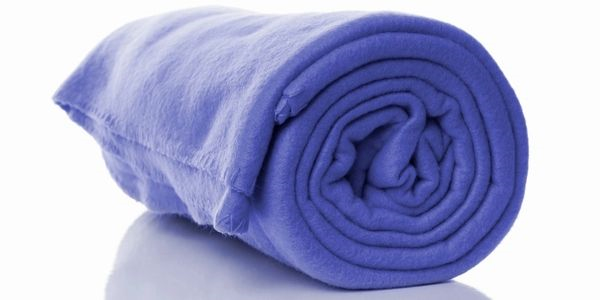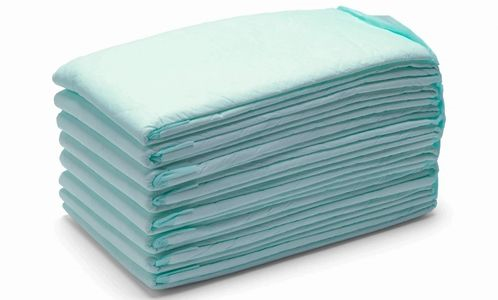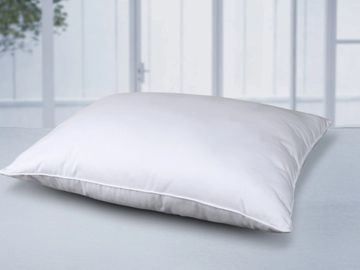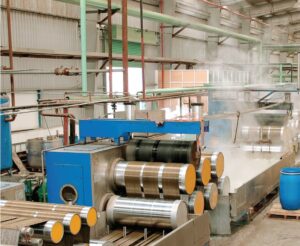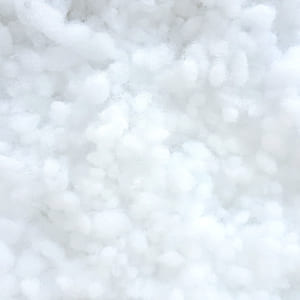In fact, there’s no right or wrong answer when it comes to choosing between our cotton or microfiber bedding. Cotton sheets are made from organic natural cotton, whereas microfiber bedding is made from high-quality synthetic fibers. One isn’t better than the other – it’s all about personal preference.
Cotton vs. Microfiber Comforters
When it comes to comforters, as well as blankets and coverlets, the choice between cotton or microfiber also comes down to personal preference. It’s all about what feels good to you!
The biggest pro of choosing a microfiber comforter is its high durability. The fabric is less likely to fade, thin, or shrink after many washes. Plus, it tends to be less expensive, providing great value if you’re on a budget. However, microfiber can sometimes be too warm for those who are hot sleepers, so if this is you, be sure to look for microfiber comforters that are lightweight.
Cotton vs. Microfiber Pillows
There’s no doubt that what you rest your head on is critical to a quality sleep experience, making pillows just as important when deciding between cotton and microfiber for your bedding.
A cotton-covered pillow is the perfect way to enjoy the benefits of breathability, cool airflow, and natural moisture-wicking ability.
Our microfiber pillow offers a dual sleep experience for those who like options. It has a cloud cell chambered construction that keeps the soft fill from shifting, ensuring consistent comfort throughout the night. The other side offers a more traditional sleep experience with an ultra-soft and smooth cover.
Our microfiber pillow was finished and treated with antimicrobial silver chloride to prevent bacteria and mildew, but the layers of Tencel and heat-responsive, paraffin-filled fibers also change from liquid to solid to aid the body’s natural process of thermoregulation.
How To Choose Between Cotton And Microfiber
| Cotton sheets | Microfiber sheets | |
| Breathability | Highly breathable | Not very breathable |
| Feel and comfort | Ranges from scratchy to smooth | Silky and smooth |
| Durability | 3-5 years | 5+ years |
| Maintenance | Moderately easy | Very easy |
| Price | $50-$500 | $30-$250 |
| Variety | Large variety | Moderate variety |
- Cotton offers better heat resistance than other fabrics, and has plenty of air circulation to keep the sleeper cool and comfortable.
- Cotton is often softer than other fabrics and will become even softer with use.
- Stains and dirt can be easier to remove from cotton bedding, using less detergent.
- Cotton is less likely to pill than man-made fabrics over time.
- Microfiber is highly durable, and is much less likely to fade or lose its shape than other fabrics, even over several years and many washes.
- Microfiber is also more wrinkle-resistant.
- Microfiber feels smooth and silky because of its tiny, thin fibers, giving it a really luxurious feeling against the skin.
- Microfiber tends to be less expensive and longer-lasting, offering the best value for your money,
Cotton vs Microfiber Sheets
Feel And Comfort
Cotton is one of the most popular fabrics used in sheets. This is partially because there are so many types of cotton sheets on the market, all with different feelings and comfort levels. The thread count of cotton sheets is one of the most significant determining factors for comfort levels, with high thread count sheets delivering a softer and luxurious feeling. In contrast, low thread count options may be scratchy and rough.
On the other hand, microfiber sheets are pretty uniform across the board. Their super-thin fibers come together in velvety soft fabric, resembling the feeling of luxurious silk sheets. However, this smooth feeling also comes with silk’s greatest weakness: a lack of breathable comfort.
Temperature
The benefits of breathability cannot be understated, especially if you live in a warmer climate. However, highly breathable sheets may not always be the right choice for your situation. So, how do cotton and microfiber measure up?
Simply put, cotton fibers are designed for hot sleepers who require sheets that quickly dissipate the additional heat coming from their bodies. As a result, these sheets tend to be much cooler and breezier.
In contrast, microfiber sheets tend to be quite densely woven, meaning less air passes through. This can also trap body heat, which can be helpful during winter.
Durability
Cotton sheets with high thread counts generally last much longer than cotton sheets with lower thread counts. Lower thread counts tend to pill more, making them less comfortable, so you’ll need to replace them sooner. On the other hand, higher quality cotton gets softer with each wash without causing the cotton to wear down.
Microfiber sheets with a flat weave fare better long-term than microfiber sheets with a waffle weave. They can withstand frequent washes without deteriorating or pilling. Flat weaves are also less likely to wrinkle or shrink when washed and dried.
Maintenance
Both microfiber and cotton sheets are fairly easy to wash. Most of the time, both microfiber and cotton sheets are safe to toss in the washing machine and dryer on the warm water setting. As a reminder, we suggest washing sheets once a week to keep them free of allergens, dead skin cells, and body oils.
Unless the sheets clearly state having other care needs, it’s safe to assume they’re machine washable. However, be sure to check the laundry care instructions first.
With this in mind, microfiber is more likely to feel staticky after being washed and dried. Microfiber with a waffle weave is also more likely to absorb moisture and it can be hard to remove stains. Some types of microfiber may also need to be washed on a low-temperature setting.
There’s also the special care that white sheets require, as they will show sweat stains moreso than a set of colored sheets. These sheets will eventually yellow with age, leaving you to whiten sheets to restore their look.
Price
Microfiber sheets and cotton sheets are both available in a wide range of price points, with affordable and luxurious variations. Still, microfiber sheet sets are cheaper on average than cotton sheets since they are synthetic. However, remember that a sound investment is about more than you just pay, it’s also about how long a product lasts. If you pay a lower price for the sheets but you have to replace them sooner, it may not be worth the cost.
Environmental Impact
If minimizing your household’s carbon footprint with your purchases is a goal of yours, then cotton sheets are the clear winner. Natural fibers require less chemicals to produce than synthetic fibers do, ensuring they have a smaller environmental impact. Plus, when you’re done with the sheets, natural materials like cotton will decay and decompose without the heavy metals and additives that synthetic fibers release.
However, when it comes to cotton sheets, not all are created with equal sustainability. Cheaper cotton sheets may have chemical treatments during production that higher-priced organic cotton sheets do not. If you want to be sure you’re purchasing a set of organic sheets, look for a certification like the Global Organic Textile Standard (GOTS).
Pros of Cotton Sheet:
- Breathable: Cotton plants produce breathable material that doesn’t trap body heat. So, this may be the perfect option for you if you live in a warmer climate and struggle with night sweats.
- Hypoallergenic: Whether you’re purchasing luxurious Egyptian cotton sheets or cheap cotton sheets, you can expect natural materials in your product. That means you’ll have reliable hypoallergenic sheets, perfect for people with skin sensitivities.
- Sturdy: While thread count is a good predictor of a durable sheet, most types of cotton bedding are usually stronger than their alternatives. Weave type plays a significant role in its durability, and you’ll get at least three years’ comfort from this bed sheet type.
- Available in countless varieties, both affordable and luxurious
- Natural fabric
- Good for people with allergies
- Low maintenance
- Durable
- Breathable and moisture-resistant
Cons of Cotton Sheet:
- Wide range of cost: Even though organic cotton sheets can come with low price tags, thread count and the type of cotton used can quickly inflate costs. For example, Egyptian cotton sheets can cost over $500 for a complete set, which can be prohibitively expensive for some.
- Shrinkable: Low-quality sheets can shrink when washed in very hot water, rendering most blankets and bedding virtually useless. This is more likely to happen when other organic materials are pulled into a tight weave with regular cotton, so pure cotton sheets may not have this issue.
- Potentially inflated thread counts
- Some variations are expensive
Pros of Microfiber Sheet:
- Wicks moisture: Despite being made from synthetic materials, microfiber fabric has natural moisture-wicking properties, similar to high-quality cotton sheets. That’s partially why microfiber towels are so popular, too.
- Stronger than natural cotton sheets: The best thing about synthetic fabrics is that they’re relatively low-maintenance. Even if you toss your microfiber blankets into the washing machine for a rigorous cycle, they’ll come out feeling new, fresh, and undamaged.
- Low maintenance
- Flat, tightly woven microfiber is durable
- Soft and lightweight
Cons of Microfiber Sheet:
- Static electricity: A typical waffle-patterned microfiber sheet tends to hold positive charges quite well, meaning you’re quite likely to experience weak static shocks while using them.
- Less breathable: Even high-end microfiber sheets can’t reach a level of breathability comparable to natural cotton sheets. That said, this can be a desirable trait for folks living in cooler climates.
- Absorbs moisture
- Prone to stains
- Staticky
- Traps heat
- Waffle-patterned microfiber is prone to moisture
Why Should You Buy Microfiber Sheets?
Microfiber bed sheets are composed of finely woven fibers made from wood pulp, polyester, or nylon polymers. They’re affordable and soft, yet they’re more durable than traditional polyester sheets. As a synthetic fabric, microfiber is less likely to wrinkle or shrink compared to all-natural fabrics like cotton.
Microfiber is measured by its denier, or each fiber’s thickness. A fabric’s denier must be less than 1 denier in diameter to be considered microfiber.
A microfiber sheets’ weave affects its durability and quality. Microfiber sheets with a flat weave are durable, resistant to stains, and repel moisture. Conversely, microfiber sheets with a waffle weave are highly absorbent and trap heat, which isn’t a reliable bed sheet.
- Low maintenance: While most kinds of bed sheets are machine washable, many of them can get damaged in rough cycles. Microfiber sheets are highly sturdy and will survive even the most thorough wash cycles, making them significantly more low maintenance than cotton.
- Crease-free: Microfiber sheets remain crease and wrinkle-free even after a wash. That means you won’t need to iron or steam your sheets before use. Your bedding and pillows will feel fresh and clean without much effort.
- No lint: Microfiber fabrics are very lint-resistant, making them the most “plug and play” experience of all bedsheets.
Why Should You Buy Cotton Sheets?
- Cool and comfortable: Cotton sheets are the number one choice for folks who need a cool and comfortable sleeping experience. Even the most densely woven cotton sheets have lots of space for air and body heat to pass through, which is essential if you have a cushy mattress protector.
- Large variety of options: Cotton sheets can range from scratchy and thin to smooth and soft – all it takes is a few dollars for the upgraded experience.
- Great for sensitive skin: If you struggle with psoriasis, eczema, or any other kind of skin condition, then cotton is unbeatable. It’s hypoallergenic and incredibly soft, so it won’t irritate or exacerbate any skin sensitivities or issues.

